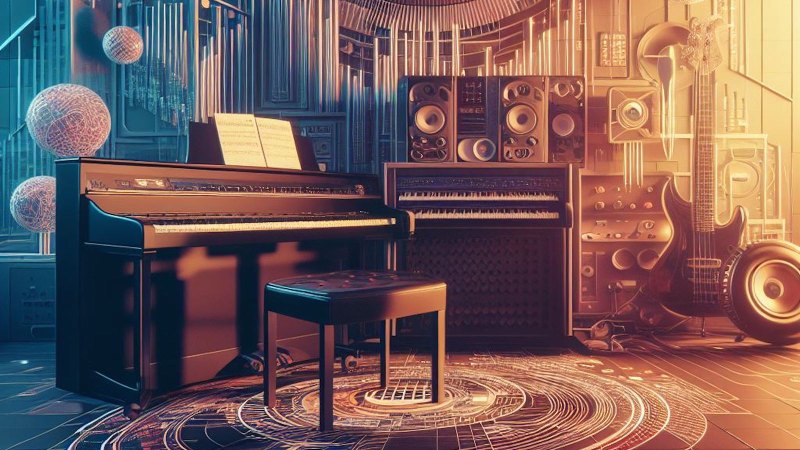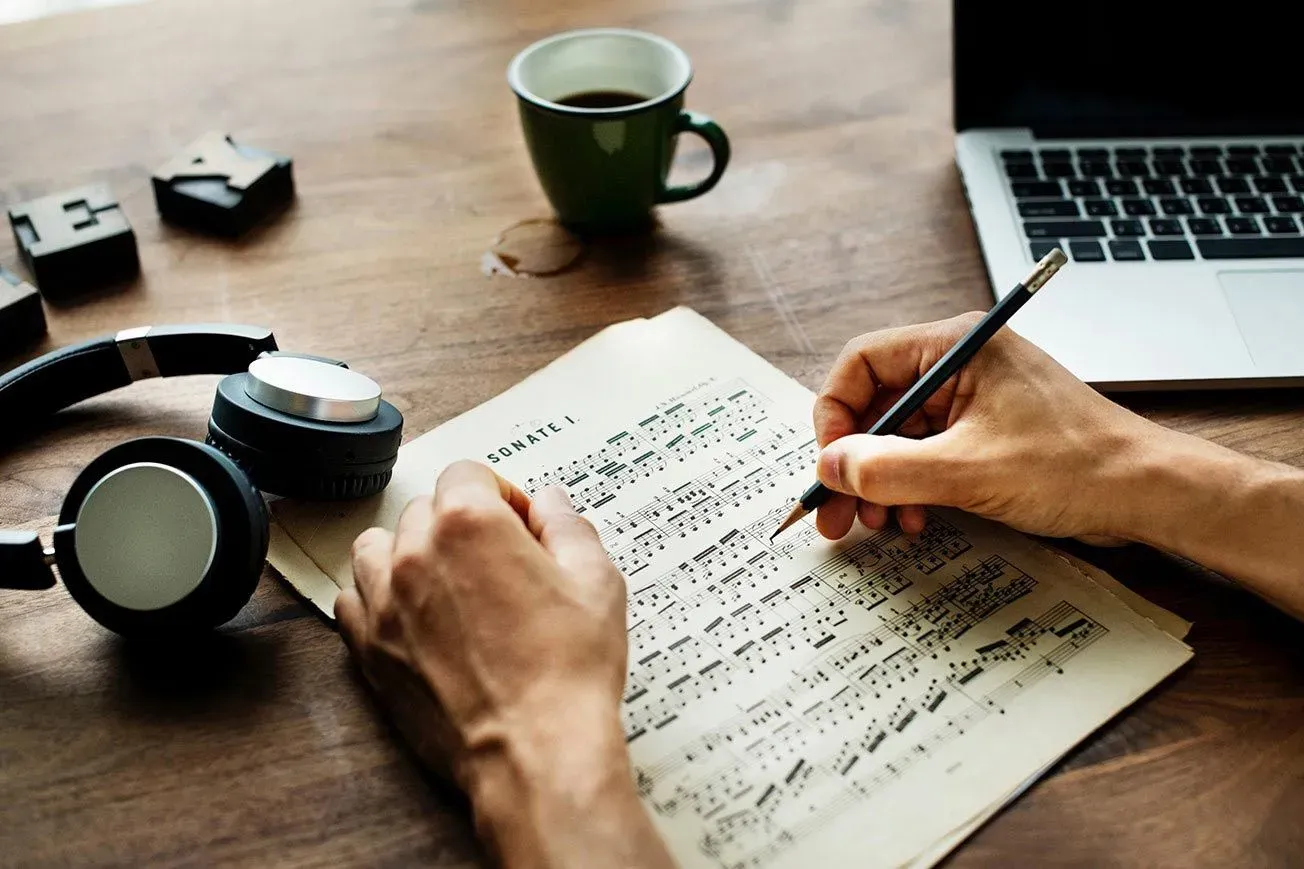From the grand concert halls of Vienna to the cozy living rooms of suburban homes, one instrument stands out as a universal symbol of musical elegance and sophistication: the piano.
But what is it about those 88 keys that has captivated and charmed listeners for centuries?
Let's journey into the world of the piano and uncover its magic.

The Piano: Chronicles of a Timeless Musical Masterpiece
The piano is celebrated as one of the most revered and adaptable instruments in the realm of music.
Its storied past, significant influence on musical compositions, and distinct structure have solidified its iconic status in both traditional and modern musical settings.
The Evolution of the Piano: From Harpsichord to Pianoforte
The journey of the piano didn't begin with the 88 keys we recognize today. Long before the first piano was crafted, there were instruments like the harpsichord and clavichord, popular during the Renaissance era.
While they laid the foundation, these instruments lacked the dynamic range the modern piano would introduce.
The real breakthrough emerged in the early 18th century with the introduction of the pianoforte.
This advancement was transformative, offering musicians the ability to modulate sound volume—a capability earlier instruments lacked.
Derived from Italian, 'pianoforte' combines "piano" (soft) and "forte" (loud), aptly highlighting the instrument's unique characteristic: its capacity to generate tones ranging from gentle whispers to robust resonances.
The Modern Marvel: 88 Keys of Versatility
Modern pianos boast a standard of 88 keys, a vast expanse that offers a remarkable range of notes. This extensive array of keys gives the piano a unique advantage.
It can mimic the tonal qualities of almost any instrument in an orchestra, from the deep resonance of a double bass to the high trills of a piccolo.
This versatility allows it to stand alone as a solo instrument or seamlessly blend into ensemble performances.
Furthermore, the piano's design, both externally with its sleek wooden frame and internally with its intricate hammer and string mechanism, showcases centuries of craftsmanship and innovation.
This design not only ensures durability but also contributes to the rich, full-bodied sound that pianos are renowned for.
The Piano's Impact on Music
Throughout the ages, the piano has been instrumental in molding musical pieces, styles, and renditions.
Its expansive range and adaptability have endeared it to composers, providing them with an extensive palette to craft their musical visions.
From classical sonatas to jazz improvisations, from rock ballads to pop hits, the piano's influence is omnipresent, solidifying its status as a timeless instrument.
Different Types of Pianos
In the intricate world of music, the piano stands out as a versatile instrument, offering myriad variations in design, sound, and functionality.
While the basic structure remains consistent—a keyboard and the ability to produce music—there are subtle and sometimes profound differences that make each type of piano unique. Delve into the diverse range of pianos available, each with its own story, design, and musical potential.
1. Grand Pianos: The Epitome of Elegance and Acoustic Mastery
Grand pianos, with their iconic horizontal soundboards, are the oldest and most revered members of the piano family.
Their design allows for a more expansive soundboard and longer strings, which contribute to a richer, louder sound.
- Petite Grand Piano: As the smallest member of the grand family, measuring between 4′ 5″ to 4′ 11″, it's perfect for smaller spaces. Its sound can be likened to an upright piano due to its size.
- Baby Grand Piano: A popular choice for domestic settings, baby grand pianos offer a balance of size and sound. They typically measure between 5’ to 5’5”.
- Medium Grand Piano: Often referred to as classical grand pianos, they find their home in both living rooms and intimate concert settings, measuring between 5′ 6″ and 5′ 8”.
- Professional Grand Piano: With a length of around 6’, these pianos are favored by professional pianists, offering superior tonal performance and playing feel.
- Parlor Grand Piano: These pianos, measuring between 6’3” to 6’10”, were originally designed for the aristocratic homes of yore. They boast excellent tonal characteristics suitable for large living rooms or medium-sized concert halls.
- Semi-Concert Grand Piano: Ideal for concert venues, these pianos, around 7 feet in length, are favored by many professional pianists for their powerful sound.
- Concert Grand Piano: The grandest of them all, these pianos measure around 9”, offering unmatched volume output and tonal richness.
2. Upright Pianos: Compact Yet Captivating
Distinct from grand pianos, upright pianos feature strings that are perpendicular to the ground, making them more space-efficient.
While they might not match the grand piano's tonal richness, they are ubiquitous in homes, schools, and conservatories.
These pianos come in variations like spinet, console, studio, and professional upright pianos.
Despite the differences in size and sound, most upright pianos adhere to the modern standard of 88 keys.
3. Electric Pianos: The Fusion of Technology and Tradition
Emerging in the 1920s, electric pianos mark the confluence of traditional design and modern technology.
They employ electrical circuits instead of the conventional hammer-string system.
Digital keyboards, encompassing digital pianos, synthesizers, and MIDI interfaces, represent this group.
Digital pianos leverage sophisticated sound sampling techniques to mimic the deep resonance of traditional acoustic pianos, providing diverse tonal options and enhanced mobility.
Synthesizers and electric pianos, on the other hand, simulate sounds using oscillators and filters, covering a vast sonic landscape beyond just piano sounds.
4. BONUS: Hybrid Pianos: The Best of Both Worlds
A 21st-century innovation, hybrid pianos aim to amalgamate the benefits of both acoustic and digital pianos.
These instruments have the traditional hammer-string system, allowing them to function as acoustic pianos.
However, their added MIDI capabilities make them incredibly versatile, opening up a world of digital possibilities.
Types of Keyboards
In the vast realm of musical instruments, keyboards emerge as a modern, adaptable counterpart to the traditional piano.
Their versatility, portability, and diverse features cater to a range of musical needs, from songwriting to sound design.
Whether you're an amateur exploring the world of music or a professional producer, there's a keyboard tailored for you.
1. Arranger Keyboards: Crafting Songs with Ease
Ideal for both novice and seasoned songwriters, arranger keyboards come equipped with a myriad of built-in rhythms, accompaniments, and sound samples.
These features facilitate the songwriting process, allowing composers to envision and craft full-fledged musical pieces without the need for additional instruments or equipment.
The intuitive interfaces of these keyboards enable musicians to experiment with various styles, making the journey of song creation both effortless and enjoyable.
2. Workstations: The All-in-One Music Production Hub
For those delving deep into the world of music production, workstations stand out as indispensable tools.
These keyboards are powerhouses, combining the capabilities of synthesizers, sound modules, and sequencers.
Equipped with advanced sequencing and recording features, workstations allow producers to compose, arrange, and edit multiple tracks simultaneously.
Their extensive sound libraries, coupled with sound editing tools, provide producers with a comprehensive platform to craft intricate musical pieces, bridging the gap between inspiration and realization.
3. Synthesizers: Unleashing Sonic Creativity
Diving into the realm of sound design and electronic music production, synthesizers emerge as instruments of limitless potential.
Unlike traditional keyboards that replicate conventional instrument sounds, synthesizers generate and shape sounds through electronic means.
With a plethora of sound-shaping options, from oscillators to filters and modulation sources, synthesizers grant musicians the freedom to create unique tones and textures.
Whether it's crafting the pulsating bass of an EDM track or the ethereal pads of ambient music, synthesizers open the doors to uncharted sonic territories.

Types of VSTs: The Digital Alchemy in Music Production
The world of music production has been redefined with the advent of Virtual Studio Technology (VST).
These digital marvels bring the soul of classic instruments to the fingertips of producers, allowing for a blend of traditional warmth and modern versatility.
Among the myriad of tools available, piano VSTs hold a special place, capturing the intricate nuances and tonalities of their acoustic inspirations.
Let's explore some of the standout piano VSTs that are reshaping the musical landscape.
1. Spectrasonics Keyscape: A Spectrum of Sonic Brilliance
Keyscape stands as a testament to Spectrasonics' dedication to sonic perfection.
This expansive library boasts over 500 piano sounds, offering a vast palette ranging from the intimate timbres of upright pianos to the resounding echoes of grand pianos.
A noteworthy highlight is the meticulously crafted sound of the Yamaha C7 grand piano, enriched with Renner® “Blue Point” hammers and Wicker felt, delivering an unparalleled tonal depth.
The flexibility provided by its VST editor window ensures that producers can tailor the sound to their precise needs, be it a soulful solo or an atmospheric soundscape.
Given its comprehensive offerings, it's imperative to have a robust system for an optimal Keyscape experience.
2. Garritan CFX: Crafting Authenticity
The Garritan CFX library is a confluence of precision and passion.
By capturing the essence of the iconic Yamaha CFX Concert Grand at Abbey Road Studios, this library offers a sound that resonates with authenticity.
With a plethora of presets and up to 20 velocity layers per key, it provides both depth and versatility.
Its harmonious integration with the ARIA player and the inclusion of industry-standard microphones make it an invaluable tool for producers seeking genuine piano sounds.
3. Vienna Imperial by VSL: Pioneering Sound Design
Vienna Imperial immerses producers in a world of sonic opulence. Centered around the majestic Bösendorfer 290-755, this VST offers an experience that is both rich and nuanced.
It empowers producers with extensive customization options, from tweaking frequencies to adjusting microphone positions.
The clear tone of the Imperial, combined with its comprehensive presets, ensures a seamless blend in diverse musical compositions.
Moreover, its built-in EQ and Reverb settings are a testament to VSL's commitment to providing an all-encompassing sound design tool.
4. Ravenscroft 275 by VI Labs: Precision Embodied
The Ravenscroft 275 is a masterstroke in the VST landscape. Crafted using approximately 17,000 individual samples, it captures the Model 275 Titanium concert grand's essence.
With four distinct microphone positions, it offers unmatched sound versatility. Its 19 velocity layers, encompassing Silent Strike samples, embody the piano's core.
Bundled with the UVI Workstation 3 and equipped with 22 convolution reverbs, the Ravenscroft ensures both authenticity and ease for producers.
5. Pianoteq 7: The Digital Maestro
Pianoteq 7 stands as a titan in modeled piano libraries. Harnessing real-time sound computation, it's light on RAM yet offers unparalleled depth.
With the ability to tap into MIDI's full 127 velocity layers, its dynamic range is vast. It meticulously models the iconic Steinway & Sons Model D and Model B, among others.
Its advanced pedal functionalities and intricate sound tweaking options set it apart, making it an indispensable tool for discerning producers.
6. Synthogy Ivory II Grand Pianos: A Trio of Titans
The Synthogy Ivory II Grand Pianos have etched their mark as industry standards in the VST realm.
Sampling from three iconic grand pianos - the Bösendorfer 290 Imperial Grand, Steinway D Concert Grand, and the Yamaha C7 Grand - this bundle offers unparalleled authenticity.
Despite the vast 77GB of sample instruments, individual piano installations offer flexibility.
Its Sustain Resonance DSP engine elevates pedal performances, while customizable pedal noises and lid positions provide nuanced control.
The plethora of presets, showcasing varied recording environments and tones, enhances its versatility.
7. Addictive Keys by XLN Audio: Budget Brilliance
Addictive Keys Studio Grand Piano stands as the quintessential budget pick, without compromising on quality.
Sampled from the revered Steinway Model D grand piano, it offers a rich tapestry of sounds.
Fundamental features like pedal noise, sustain pedal resonances, and tone adjustments are complemented by close and ambient microphone placements.
Its built-in convolution and algorithmic reverb/delay, coupled with EQ adjustments, ensure a sound profile tailored to every need.
From pristine grand piano sounds to experimental textures, its diverse presets cater to a wide sonic palette.
Piano's Role in Music: A Timeless Instrument
The piano, with its unmistakable timbre and versatility, has carved a unique space across musical genres.
Its ability to seamlessly transition between classical compositions and modern pop hits underscores its importance in the musical world.
Whether leading a symphony or laying the foundation in a rock ballad, the piano has proven itself to be an instrument of depth, rhythm, and melody.
This adaptability has made the piano the go-to for many composers and songwriters, serving as a bridge between diverse musical landscapes.
Piano in Modern Popular Music: A Universal Presence
The piano's omnipresence in modern popular music is undeniable.
Its resonant tones can be found echoing in the heart of classical compositions, the soulful rhythms of jazz and blues, and the catchy hooks of rock and pop.
As one ventures deeper into the realm of music, understanding the nuances between these styles becomes imperative.
This mastery not only elevates one's proficiency but also enhances the overall musical experience.
A Lasting Impact: The Piano's Contemporary Influence
From the timeless classics of Elton John and Billy Joel to the modern masterpieces of today's artists, the piano's influence is evident.
The piano has been instrumental in defining the auditory landscapes of the 20th century and remains influential today.
Its adaptability makes it a staple in varied genres, from rock and hip-hop to electronic tunes.
Given its harmonic depth and melodic capabilities, the piano's imprint on modern music is sure to echo for years to come.
Exploring Versatility: Piano Across Genres
The piano's chameleon-like ability to fit into any musical genre is truly remarkable. In rock, it often takes center stage, driving the melody.
In hip-hop and electronic music, it often provides a rich backdrop, setting the tone.
Jazz sees the piano as a canvas for improvisation. This adaptability has ensured that the piano remains relevant, making it an indispensable tool for modern musicians.
Songwriting's Best Friend: The Piano's Integral Role
For numerous composers, the piano transcends its role as a mere instrument; it becomes an inspiration.
Its expansive range fosters creativity with chords and melodies, often serving as the foundational element for many musical pieces.
The digital age has further amplified its potential, offering tools for easy recording and editing. The piano's undeniably significant role in songwriting is a testament to its timeless appeal.
Decades of Evolution: The Piano's Journey
Starting with the fervent rock and roll era of the 1950s and 1960s, where icons like Jerry Lee Lewis ignited stages, and continuing through the melodic pop heydays of the 1970s and 1980s, graced by legends like Elton John, the piano has consistently occupied a pivotal role in the ongoing evolution of music.
As the digital revolution of the 1990s and 2000s reshaped the musical landscape, the piano seamlessly integrated itself into electronic and hip-hop genres, firmly establishing its enduring significance in popular music.
R&B and Soul: The Piano's Soulful Heart
In the realms of R&B and Soul, the piano's emotive capabilities come to the fore. Artists like Stevie Wonder and Lauryn Hill have leveraged its rich tones to craft timeless classics.
Whether it's soulful ballads or upbeat tracks, the piano adds depth and emotion, making it an essential component of the genre.
From Liberace to Elton John: Celebrating Modern Pianists
Pianists have always been at the forefront of popular music.
From the extravagant showmanship of Liberace to the soulful interpretations of Elton John, these musicians have spotlighted the piano's incredible adaptability.
Their influence has not only heightened the instrument's renown but has also acted as a source of inspiration for a fresh wave of pianists.
Electronica and Hip-hop: The Piano's Modern Beat
Within the realm of electronic and hip-hop music, the piano has discovered a renewed voice.
Its timeless timbres effortlessly meld with modern rhythms, infusing contemporary tracks with a hint of nostalgia.
This fusion has introduced the piano to a new generation of listeners, ensuring its legacy continues.
Embracing Technology: The Piano's Digital Renaissance
The digital age has ushered in a new era for the piano.
Modern pianists and producers are leveraging digital tools to craft unique sounds, while production techniques like sampling and looping have expanded its potential.
Today, the piano is not just a musical instrument but a symbol of the fusion of tradition and technology.

Step into the future of music creation with Empress!
Whether you're an aspiring artist or a seasoned professional, Empress provides advanced AI music tools to enhance your compositions and realize your musical aspirations. Stay ahead and embrace the future of music with us. Explore Empress today and let your creativity know no bounds.
FAQs:
Q1: What are VSTs and why are they significant in music production?
VSTs (Virtual Studio Technology) are digital software versions of musical instruments, crucial for replicating authentic instrument sounds without the need for the physical instrument.
Q2: How do keyboards differ from traditional pianos in music?
While traditional pianos are revered for their acoustic depth and sophistication, keyboards offer portability, versatility, and a range of electronic sounds suitable for various genres.
Q3: Why is the piano considered versatile across different music genres?
The piano's wide range, harmonic depth, and ability to convey emotions make it adaptable to various genres, from classical to rock, jazz to pop.
Q4: How has modern technology impacted the traditional role of the piano in music?
Technological advances have led to the evolution of pianos, introducing digital and electric variations and integrating them into modern music genres like electronic and hip-hop.
Q5: What's the significance of the different types of pianos like grand and upright?
Different types of pianos, such as grand and upright, offer varying tonal qualities, sizes, and purposes, catering to diverse musical needs from concert performances to home use.
Follow the future of music with Empress. Check out our blog to learn how you can effectively use these AI music tools.


